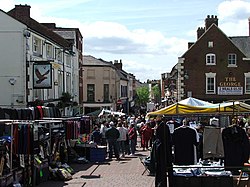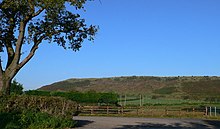Oswestry
| Oswestry Welsh: Croesoswallt | |
| Shropshire | |
|---|---|
 Oswestry Marketplace | |
| Location | |
| Grid reference: | SJ292293 |
| Location: | 52°51’35"N, 3°3’14"W |
| Data | |
| Population: | 15,613 (2001) |
| Post town: | Oswestry |
| Postcode: | SY10, SY11 |
| Dialling code: | 01691 |
| Local Government | |
| Council: | Shropshire |
| Parliamentary constituency: |
North Shropshire |
Oswestry is a town in Shropshire, close to boundary of Denbighshire. It is on the A5, the ancient route from the Midlands to North Wales. Though of modest size, Oswestry is the largest town in Shropshire after Telford and Shrewsbury. The 2001 Census recorded the population of the civil parish as 15,613, the urban area as 16,660.
Oswestry has had a mixed Welsh-speaking and English-speaking population for centuries. The parish church conducted services in Welsh until 1814.[1] Though English is the dominant language today, there are still Welsh-speaking parts of the town.
Oswestry has one of the few Welsh-language bookshops outside Wales[2] and the local library service has a collection of Welsh material, housed in Oswestry.
Name of the town
The town is named "Oswestry" in English and "Croesoswallt" in Welsh. The English name is believed to come from "Oswald's tree" (Oswaldes treow) and the Welsh name means "Oswald's cross". The name in each language is derived from St Oswald, King of the Northumbrians, who was slain in battle by King Penda of the Mercians in or close by the town.
Though the tale of King Oswald's martyrdom was often told thenceforth, the town of Oswestry is not mentioned by name but only the field of battle, Maserfelþ, which is most likely to be beside Old Oswestry, an Iron Age hill fort beside today's town.
In the Domesday Book the town is not mentioned by name but is included in the Domesday Survey it is included in the manor of Maesbury. Also hereabout is the estate of Luure, an obscure name. The first surviving written appearance of the name "Oswestry" is rather late in its history, in the town charter 1190. In a book written in 1194, Gerald of Wales calls the town Oswaldestreo.[3]
Churches

St Oswald's Church is believed to have been established soon after King Oswald fell in battle in 642, though not with its current building. The church has a Norman tower dating from 1085. There is a new window in the east nave designed by prestigious stained glass artist Jane Grey in 2004.
- Church of England (within the Diocese of Lichfield):
- St Oswald's
- Holy Trinity
- Baptist: Cornerstone Baptist
- Independent evangelical:
- Albert Road Evangelical Church
- Carreg Llwyd Church
- Cabin Lane Church (a plant from Carreg Llywd Church)
- Methodist:
- Horeb Church
- Oswestry Methodist Church
- Religious Society of Friends (Quakers)
- Seion Church (Welsh-speaking)
- United Reformed Church: Christ Church
- Holy Anglican Church Western Rite
History
Prehistory
The area has long been settled. Old Oswestry is the site of a large Iron Age hill fort with evidence of occupation dating back to the 550s BC.
St Oswald
The Battle of Maserfield is thought to have been fought here in 642, between King Penda of Mercia and Oswald of Northumbria. Oswald was killed in this battle and was dismembered; according to a legend, one of his arms was carried to an ash tree by an eagle, and miracles were subsequently attributed to the tree (as Oswald was considered a saint). Thus it is believed that the site was named "Oswald's Tree", giving a name to the town. The spring Oswald's Well is supposed to have originated where the bird dropped the arm from the tree. Offa's Dyke runs nearby to the west.
The Normans
Alan FitzFlaad (d. c1114), a Breton knight, was granted the feudal barony of Oswestry[4] by King Henry I who, soon after his accession, invited Alan to England with other Breton friends, and gave him forfeited lands in Norfolk and Shropshire, including some which had previously belonged to Ernoulf de Hesdin (killed at Antioch while on crusade) and Robert de Belleme.[5]
Alan's duties to the Crown included supervision of the Welsh border. He also founded Sporle Priory in Norfolk. He married Ada or Adeline, daughter of Ernoulf de Hesdin.[6][7] Their eldest son William was made High Sheriff of Shropshire by King Stephen in 1137. He married a niece of Robert of Gloucester.[8] But two of their younger sons, Walter fitz Alan and Simon, travelled to Scotland in the train of King David I, Walter becoming the first hereditary High Steward of Scotland and ancestor of the Stewart Royal Family.
Border town
The town, being very close to Wales, has many Welsh street names and placenames.
The Domesday Book records a castle being built by Rainald, a Norman Sheriff of Shropshire. The town changed hands between the crown and the Welsh princes a number of times during the Middle Ages. In 1149 the castle was captured by Madog ap Maredudd, and remained in Welsh hands until 1157. Later, Oswestry was attacked by the forces of Welsh rebel leader Owain Glyndŵr during the early years of his rebellion against the English King Henry IV in 1400; it became known as Pentrepoeth or 'hot town' as it was burned and nearly totally destroyed by the Welsh.
Market town

In 1190 the town was granted the right to hold a market each Wednesday. The weekly influx of farmers from the hills from far and wide required that the townsfolk trading there be bilingual.
The first charter of which a copy only is preserved among the corporation records, is one given in 1262 by John Fitzalan granting the burgesses self-government. Richard II by a charter dated 1398 granted all the privileges which belonged to Shrewsbury, and a similar charter was obtained from Thomas, Earl of Arundel in 1407. The town was incorporated by Elizabeth in 1582 under the government of two bailiffs and a common council of 24 burgesses, and her charter was confirmed by James I in 1616. A charter granted by Charles II in 1672 appointed a mayor, 12 aldermen and 15 common councilmen, and remained the governing charter until the Municipal Corporations Act of 1835 changed the corporation.
The town built walls for protection, but these were torn down by the Parliamentarians after they took the town after a brief siege on 22 June 1644, leaving only the Newgate Pillar visible today. During the Civil War, Oswestry's castle was reduced to rubble.
After the foot and mouth outbreak in the late 1960s the livestock market was moved out of the town centre. In the 1990s, a statue of a shepherd and sheep was installed in the market square as a memorial to the history of the market site.
Military
Park Hall, a mile east of the town was one of the most impressive Tudor buildings in the country. It was taken over by the Army in 1915 and used as a training camp. On 26 December 1918 it burnt to the ground following an electrical fault. The ruined hall and camp remained derelict between the wars.[9] For decades following World War 2, Oswestry was a prominent military centre for Canadian troops, later British Royal Artillery and latterly, a very successful training centre for 16-18 year old Infantry Junior Leaders. This long and proud military connection came to an ignominious end in the mid-1970s, shortly after some local licensed wildfowlers were shot by the young military guard one winter's night, mistaken for an attack by the IRA, as the locals discharged their shotguns at some passing ducks.
The area previously occupied by the Park Hall military camp is now mainly residential and agricultural land, with a small number of light industrial units.
Old Oswestry

Old Oswestry is an Iron Age hill fort a little to the north of the town, known also as Old Fort or in Welsh Hen Dinas.
It is a large and impressive early Iron Age hill fort, occupied between the sixth century BC and the Roman conquest of Britain, probably a fort of the Cornovii tribe. In the Early Saxon period the hillfort was incorporated into Wat's Dyke, and two sections this are adjacent to it.
The complexity of its defences suggests several phases of development. The site was originally occupied by a few undefended round huts. These were then enclosed by a double bank and ditch enclosure spreading over 1.3 acres). Entrances were placed through the enclosure at the east and west ends where the inner bank was pulled back inwards to create a more impressive gateway. These defences were later rebuilt and a third bank added on all sides except the south east where the hill's steep slope made further strengthening unnecessary. The western entrance was then remodelled with unusual rectangular hollows separated by ridges dug out and defended by outworks. Finally two further circuits of banks and ditches were added to the outside and a flanking bank placed alongside the eastern entrance.

Although Old Oswestry was one of the most strongly defended hill forts in Britain there is no evidence that the Roman Legions ever tried to besiege it.
During the First World War it was used as a training area for Canadian troops. Many of the large pits and trenches shown on aerial photographs relate to these military activities. [10] [11]
Old Oswestry was designated as a scheduled monument in 1997 and is now in the guardianship of English Heritage.
Sights in and near the town
Attractions in and around Oswestry include:
 Old Oswestry
Old Oswestry Whittington Castle (in nearby Whittington)
Whittington Castle (in nearby Whittington) Shelf Bank and the Cambrian Railway Museum
Shelf Bank and the Cambrian Railway Museum Brogyntyn Hall, which belonged until recently to the Barons Harlech[12]
Brogyntyn Hall, which belonged until recently to the Barons Harlech[12]
Outside links
- Oswestry Town Council
- Annual Oswestry Agricultural Show
- The Oswestry Food Festival
- The Oswestry Festival of the Word
- Oswestry Landmarks and Tourism
- Guide to Oswestry History and Archaeology
- 107.1 FM | The Severn - radio
- Oswestry & Border Counties Advertizer Newspaper
References
- ↑ "Popeth Yn Gymraeg website (Welsh)". http://www.s4c.co.uk/popethyngymraeg/c_diary3.shtml.
- ↑ "Siop Cwlwm Website". http://www.siopcwlwm.co.uk/.
- ↑ Gerald of Wales: The Itinerary of Archbishop Baldwin through Wales, Book II, Chapter XII: De transita per Album monasterium et Oswaldestreo; Powisiam quoque et Slopesburiam; cum notabilibus suis – "Of the journey by the White Monastery, Oswaldestroe, Powys, and Shrewsbury": "We slept at Oswaldestree, or the tree of St Oswald, and were most sumptuously entertained after the English manner, by William Fitz-Alan, a noble and liberal young man." (Apud Oswaldestroe, id est Oswaldi arborem, pernoctavimus ... )
- ↑ Burke, Messrs., John and John Bernard, The Royal Families of England, Scotland, and Wales, and Their Descendants &c., volume 2, London, 1851, p. xl.
- ↑ Ritchie, R. L. Graeme, The Normans in Scotland, Edinburgh University Press, 1954, p.280-1
- ↑ Round, J. H., Studies in Peerage, p.123
- ↑ Ritchie (1954) p.98n and 280-1
- ↑ Ritchie (1954) p.281
- ↑ Shropshire Routes to Roots. "Introduction to Park Hall". Shropshire County Library Service. http://www3.shropshire-cc.gov.uk/roots/packages/war/war_h01.htm.
- ↑ http://www.pastscape.org.uk/hob.aspx?hob_id=66112
- ↑ http://www.english-heritage.org.uk/publications/marches-uplands-mapping-project-nmp Marches Uplands Mapping Project
- ↑ Brogyntyn article and image